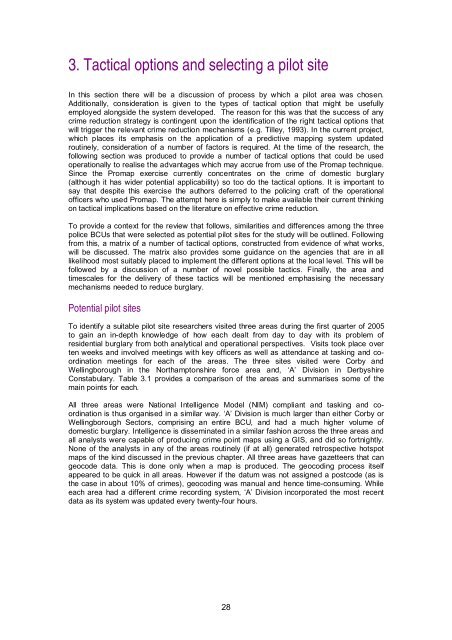Prospective crime mapping in operational context Final report
Prospective crime mapping in operational context Final report
Prospective crime mapping in operational context Final report
- No tags were found...
Create successful ePaper yourself
Turn your PDF publications into a flip-book with our unique Google optimized e-Paper software.
3. Tactical options and select<strong>in</strong>g a pilot siteIn this section there will be a discussion of process by which a pilot area was chosen.Additionally, consideration is given to the types of tactical option that might be usefullyemployed alongside the system developed. The reason for this was that the success of any<strong>crime</strong> reduction strategy is cont<strong>in</strong>gent upon the identification of the right tactical options thatwill trigger the relevant <strong>crime</strong> reduction mechanisms (e.g. Tilley, 1993). In the current project,which places its emphasis on the application of a predictive <strong>mapp<strong>in</strong>g</strong> system updatedrout<strong>in</strong>ely, consideration of a number of factors is required. At the time of the research, thefollow<strong>in</strong>g section was produced to provide a number of tactical options that could be used<strong>operational</strong>ly to realise the advantages which may accrue from use of the Promap technique.S<strong>in</strong>ce the Promap exercise currently concentrates on the <strong>crime</strong> of domestic burglary(although it has wider potential applicability) so too do the tactical options. It is important tosay that despite this exercise the authors deferred to the polic<strong>in</strong>g craft of the <strong>operational</strong>officers who used Promap. The attempt here is simply to make available their current th<strong>in</strong>k<strong>in</strong>gon tactical implications based on the literature on effective <strong>crime</strong> reduction.To provide a <strong>context</strong> for the review that follows, similarities and differences among the threepolice BCUs that were selected as potential pilot sites for the study will be outl<strong>in</strong>ed. Follow<strong>in</strong>gfrom this, a matrix of a number of tactical options, constructed from evidence of what works,will be discussed. The matrix also provides some guidance on the agencies that are <strong>in</strong> alllikelihood most suitably placed to implement the different options at the local level. This will befollowed by a discussion of a number of novel possible tactics. F<strong>in</strong>ally, the area andtimescales for the delivery of these tactics will be mentioned emphasis<strong>in</strong>g the necessarymechanisms needed to reduce burglary.Potential pilot sitesTo identify a suitable pilot site researchers visited three areas dur<strong>in</strong>g the first quarter of 2005to ga<strong>in</strong> an <strong>in</strong>-depth knowledge of how each dealt from day to day with its problem ofresidential burglary from both analytical and <strong>operational</strong> perspectives. Visits took place overten weeks and <strong>in</strong>volved meet<strong>in</strong>gs with key officers as well as attendance at task<strong>in</strong>g and coord<strong>in</strong>ationmeet<strong>in</strong>gs for each of the areas. The three sites visited were Corby andWell<strong>in</strong>gborough <strong>in</strong> the Northamptonshire force area and, ‘A’ Division <strong>in</strong> DerbyshireConstabulary. Table 3.1 provides a comparison of the areas and summarises some of thema<strong>in</strong> po<strong>in</strong>ts for each.All three areas were National Intelligence Model (NIM) compliant and task<strong>in</strong>g and coord<strong>in</strong>ationis thus organised <strong>in</strong> a similar way. ‘A’ Division is much larger than either Corby orWell<strong>in</strong>gborough Sectors, compris<strong>in</strong>g an entire BCU, and had a much higher volume ofdomestic burglary. Intelligence is dissem<strong>in</strong>ated <strong>in</strong> a similar fashion across the three areas andall analysts were capable of produc<strong>in</strong>g <strong>crime</strong> po<strong>in</strong>t maps us<strong>in</strong>g a GIS, and did so fortnightly.None of the analysts <strong>in</strong> any of the areas rout<strong>in</strong>ely (if at all) generated retrospective hotspotmaps of the k<strong>in</strong>d discussed <strong>in</strong> the previous chapter. All three areas have gazetteers that cangeocode data. This is done only when a map is produced. The geocod<strong>in</strong>g process itselfappeared to be quick <strong>in</strong> all areas. However if the datum was not assigned a postcode (as isthe case <strong>in</strong> about 10% of <strong>crime</strong>s), geocod<strong>in</strong>g was manual and hence time-consum<strong>in</strong>g. Whileeach area had a different <strong>crime</strong> record<strong>in</strong>g system, ‘A’ Division <strong>in</strong>corporated the most recentdata as its system was updated every twenty-four hours.28
















